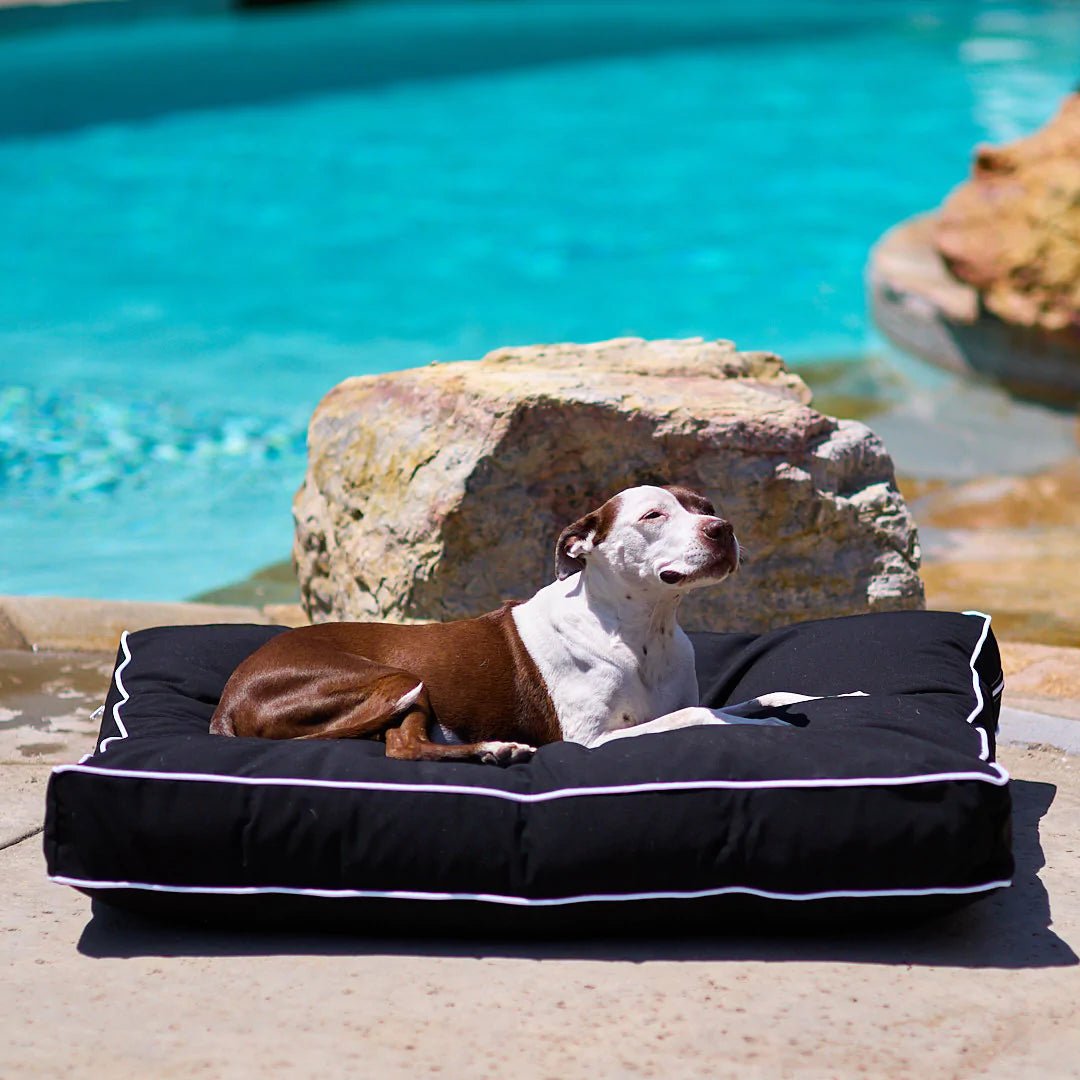Dog Science Series: How Do You Tell if Your Dog is Too Hot or Too Cold?

Part of keeping your furry family member comfortable and healthy is ensuring that your dog is neither too hot nor too cool. In extreme weather, your pet may need help maintaining body temperature: that is, you may have to help keep your dog cool or warm. Dogs also have more trouble maintaining their body temperature than humans, especially in hot weather, since they do not sweat the way humans do and have heavy fur coats.
How can you tell if your dog is too hot or too cold? Temperature tolerance may vary dramatically by breed, which means that there is no perfect rule of thumb. Huskies, for example, may thrive in cold weather, but struggle on humid days or in the summer heat. Pay attention to these key warning signs.
Signs Your Dog is Too Hot
Your dog can generally stay comfortable in weather up to 81-85 degrees Fahrenheit. However, as temperatures climb during the summer months, you may need to pay more attention to signs that your dog might be too hot or even dehydrated. Make sure you watch your dog carefully for signs of overheating in the summer heat to avoid heat exhaustion.
1. Your dog is panting excessively.
Some panting is normal and healthy for your dog, since it can help your dog cool down. However, if you notice your dog panting heavily, it could indicate that your dog has become overheated. Excessive drooling may also indicate overheating.
2. Your dog appears weak or low-energy.
As your dog gets too hot, they may have the same problem getting up and acting energetic that you might. As you notice your dog's energy decreasing, it could indicate that your dog has overheated. Offer some cool water and get your dog out of the heat.
3. You notice your dog seeking shade or air conditioning.
Like a human, your dog may show a clear preference for air conditioning during the hot summer months. You may notice if that if your dog is feeling particularly hot, they will seek air conditioning. On a hot day, your dog may prefer to stay indoors more often.
Signs Your Dog is Too Cold
During the colder winter months, you may notice some obvious signs that your dog is too cold. Even though your dog has a fur coat that can help keep them warmer, they may not have the ability to maintain body heat in very cold weather.
1. Your dog is shivering or shaking.
Like you, your dog may shiver and shake in the cold to help increase overall body temperature and get more comfortable. A shivering dog is likely very cold or uncomfortable already, and you may need to address symptoms and get your pooch warmed up as soon as possible.
2. Your dog tucks their legs, tail, or ears closer to the body.
Just like you might curl in, wrap your arms around yourself, or try to curl into a smaller ball in order to conserve body heat when very cold, your dog may do the same. You may notice your dog curling up in a tighter ball or holding their body more tightly to try to stay warm.
3. You notice your dog whining about the cold.
Often, your dog will let you know that they're uncomfortable in the cold. If you hear your dog whining or barking to be let in, it could indicate that the cold is getting to them.
How Can You Keep Your Dog Comfortable in All Weather?
As a responsible pet owner, you may need to pay careful attention to your dog's overall comfort regardless of the weather outside. Try these key tips to protect your dog regardless of the weather.
1. Never leave your pet in a hot car.
Even if you think you will be back within just a few minutes, never leave your pet unattended in a car. Heat exhaustion can occur in a matter of minutes, especially in high summer temperatures.
2. Make sure that your dog has a source of fresh water at all times.
Cold water is particularly important in the summer heat. Make sure you offer plenty of water to dogs who have heavier coats.
3. Let your dog lead the way.
Your dog will likely start to seek shelter or whine to come inside if they feel uncomfortable outside. You may also notice your dog burrowing into their dog blanket to get warm. If you notice your dog's temperature tolerance changing along with the seasons, allow them to spend more time inside. While different dog breeds may have different temperature tolerance levels, and individual dogs may vary even between those groups, it's important to listen to what your dog is trying to tell you.
4. Protect your dog's paws.
Pavement temperatures may rise faster than exterior temperatures during the summer. During hot weather, you may want to take long walks in the early morning, when the pavement is cooler, or allow your dog to walk on the grass when possible. Hot pavement can burn the bottom of your dog's feet.
Cold weather can also prove problematic for your furry friend's paws, especially if you have a short-hair breed. Protect your dog's footpads with boots or by keeping outside trips short to avoid frostbite.
Excessive heat or cold can lead to serious complications for your furry friend. Dog owners should take immediate action at the first sign of a problem with their pets to avoid further complications. Do you have more questions about keeping your dog comfortable during all seasons? Contact us today.
FAQ
What are the signs of an overheated dog?
A dog nearing heatstroke will have several clear signs, including extreme panting and heavy saliva. Overheating can occur quickly, and dogs may not have the means to cool themselves down as body temperature continues to rise.
How do dogs act when they're cold?
If your pup is cold, he may start shaking or shivering as his body attempts to warm itself. Often, dogs who are cold will tuck their legs and tail closer to the body in an attempt to keep them warmer. They may also seek sources of warmth.
At what temperature do dogs get uncomfortable?
The temperature that is uncomfortable for your dog, specifically, may depend on your breed. Dogs generally do well as long as the temperature remains above 45 degrees Fahrenheit and below 81-85 degrees Fahrenheit.
Subscribe
Sign up to get the latest on sales, new releases and more…
Categories
- Tails of Celebration: Working Dogs of the Lares Trek, A Silent Partnership In Peru
- 5 Easy Organic Christmas Recipes for Dogs: Simple Holiday Treats Your Companion Will Love
- The 6 Best Luxury Gifts for Your Dog This Christmas: Thoughtful Holiday Comfort That Truly Lasts
- Why Playtime Matters: The Benefits of Mental Stimulation and Playtime with Your Companion
- Tails of Celebration: The Miao Dog-Carrying Festival - A Hero's Honor in China
- A Dog-Friendly Thanksgiving 2025: Comfort, Calm, and Easy Treat Recipes
- The Best Dog Beds for Winter 2025: 5 Luxury Styles for Warmth, Comfort & Orthopedic Support
- Tails of Celebration: The Feast of Saint Hubert — Belgium's Timeless Blessing
- Halloween Safety Tips for Dogs: How to Keep Your Companion Safe This Spooky season
- Tails of Celebration: Día de los Muertos / Day of the Dead for Pets, A Festival of Memory in Mexico
- How to Care for Senior Dogs in Fall: Mobility Tips & Joint Support
- Tails of Celebration: Kukur Tihar & The Tihar Festival of Nepal
- What is a VDI Testing for dogs ? : Insights, Procedures and Preventive Measures
- Cheap Dog Beds vs. Luxury Dog Beds: The Real Cost of a $50 "Disposable" Dog Bed
- Can Dogs Have OCD? Understanding Canine Compulsive Behaviors (CCD)
- Does My Dog Like Music? Find Out What Tunes Make Your Pup Wag!
- Effective Solutions for Food Aggression in Dogs
- 7 Frozen Treats Your Dog Will Love This Summer☀️🧊🍉
- The Best Waterproof Liners for Dog Beds: Protect Against Spills, Drool, and Accidents
- How to Cope with the Loss of a Dog: A Tribute to Every Companion We Carry in Our Hearts
- Top Tips on How to Prevent Matting in Dogs
- Understanding and Managing Dogs with Hip Dysplasia
- The Ultimate Guide to Dog Gut Health: Natural Remedies, Probiotic Insights and Signs of Poor Gut Health
- The Best Supplements for Dogs: Explore Top Picks for Canine Health and Wellness
- How Often Should I Brush My Dog's Teeth? Tips for Optimal Canine Dental Health
- Ultimate Guide on How to Comfort Your Dog During Fireworks this 4th of July
- Managing a Blowing Coat: Essential Grooming Tips for Double-Coated Dogs.
- 5 Daily Habits That Boost Your Dog’s Long-Term Wellness
- Mastering Crate Training a Dog: Tips and Benefits
- Dog Car Seats vs. Seat Covers: What’s The Best Option For Your Companion?
- Best Outdoor Dog Beds: Luxury, Durability, and Unmatched Comfort
- Is My Dog Overweight? Tips to Assess and Help Your Companion
- The Best Faux Fur Dog Beds for Ultimate Pet Comfort of 2025
- Dog Running Guide: How to Start, Train & Stay Safe when running with your Dog
- Indestructible Dog Beds? The Truth Behind the Term
- Top Tips for Effective Exercise for Dogs
- Effective Dog Ear Cleaning: A Step-by-Step Guide for Maintaining Healthy Ears
- How to Manage Dog Aggressive Behaviors: Expert Tips and Advice
- Effective Canine Ear Infection Remedies: Symptoms, Causes & Treatments
- How to Make a New Dog Comfortable in Their New Home - 2025 Guide
- Signs of Dog Allergy Symptoms and How to Help and Prevent Them
- Why Does My Dog Lick Their Paws? Causes and Solutions Explained
- Dog Alzheimer's: Symptoms, Causes, and Treatment Options
- The Legacy of Comfort with the Iconic Animals Matter® Ortho Companion-Pedic® Puff Luxury Dog Bed
- Orthopedic Square Dog Beds: The Ultimate Blend of Luxury, Comfort, and Support
- Loungers: The Ultimate Beds for Luxury, Comfort, and Orthopedic Support
- Square Dog Beds: Orthopedic Comfort and Stylish Designs for Your Companion
- Effective Solutions for Canine Incontinence: Identifying Causes and Best Treatments
- Ethical, Sustainable, and Certified: Why Certified Products Matter, Exploring CA Prop 65 and CertiPUR-US® Standards
- Dog Seizures: Signs, Causes, and How to Help Dogs with Seizures


Leave a comment
Please note, comments must be approved before they are published